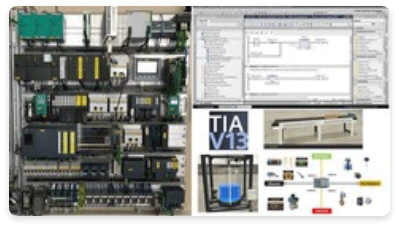- Accueil
- Prestations
- Technologies
- Portfolio
- Formations
- Blog
- CONTACTS
- Retrouvez nous sur
Robotics no-code with Augmentus - Daryl LIM | Autem
Robotic No-Code with Augmentus: Complex Robot Programming Simplified with Augmentus - Daryl LIM
Intro et présentation
Programming robots is a highly challenging task that demands long hours of work. Daryl , in collaboration with his co-founders, established Augmentus in 2019. Augmentus is a robotics platform that leads in intelligent 3D scanning and AI robot motion planning systems. These innovations enable no-code robot programming within minutes. Augmentus utilizes proprietary technologies for easy and rapid digitization of work environments, automated robot path generation, and an intuitive graphical interface. This eliminates the need for coding and CAD files in robot teaching. Leading robotics and advanced manufacturing companies worldwide employ Augmentus' products for various applications, including robot sandblasting, shot peening, sanding, painting, spraying, and welding. Augmentus empowers manufacturers to achieve a faster return on investment (ROI) by reducing the time, cost, and skill barriers in industrial automation. Companies using Augmentus have reported cost reductions of up to 70% and deployments over 21 times faster. This article explores the benefits of Augmentus, which combines no-code programming with AI.
Programming problem
Augmentus seeks to alleviate these challenges by offering an intelligent and adaptive robotics platform. This platform leverages computer vision and artificial intelligence to eliminate the need for extensive coding and reduce downtime in robotics. The goal is to make automation more accessible, cost-effective, and efficient by addressing the hidden costs associated with software, programming, and downtime in robotic operations. Several key issues were identified as drivers for creating this solution:
- 1- High Mix Processes: Many manufacturing processes involve frequent changes or variations in the parts to be handled by robots. Traditional programming methods required extensive time and effort to adapt robots to these changes.
- 2- CAD File Dependency: Programming robots for complex motions like polishing or welding often relies on CAD files. However, many customers did not have access to accurate CAD files, leading to programming challenges.
- 3- Skill Shortage:: There is a shortage of skilled professionals in both robotic programming and manual tasks such as welding, painting, or spraying, making it challenging to find the right talent.
- 4- Fragmentation:: Different robot vendors and programming languages create fragmentation and complexity in automation projects, often requiring the hiring of multiple experts with knowledge of specific technologies.
AUGMENTUS Solution
Augmentus consists of two main parts. The first part is
a 3D scanning solution with computing
hardware, including a laser scanner attached to a robotic arm or used in
a handheld manner. This scanner uses machine
vision to 3D scan parts with up to 0.05 millimeters of precision, making
it highly accurate, especially for applications
like welding, grinding, or polishing. It essentially allows the robot to
"see" the process.
The second part is the software, which acts as the
"brain" of the system. It is a simulation software
capable of
combining the computer vision data from the scanner with built-in
artificial intelligence to eliminate the need for
coding, programming, and teaching for robots. This system is primarily
aimed at complex parts and processes, such as
complex shapes of parts like aircraft airfoils, automotive assembly
lines, or oil and gas pipes.
The three key benefits of Augmentus as follows:
- 1- Automatic generation of complex robot motions for various robot hardware.
- 2- Adaptation to part changes with zero downtime through 3D scanning and automated motion planning.
- 3- Correction of variances and deviations between parts to ensure optimal performance in welding or other processes.
The size of parts the Augmentus system can handle varies, with a capability ranging from very small parts, as small as 2 cm x 5 cm, to very large parts, such as aerospace rings up to 10 meters long. The limits are primarily related to the robot's reach and external access, such as the length of linear tracks.
AUGMENTUS Workflow
The workflow of our Augmentus to address the previously mentioned
problems consists of several steps. First, you begin with
part scanning. You can do this
using our mentioned 3D
scanners or by importing CAD files to generate a simulation
environment. Next, the robotic operator simply selects the surfaces or
edges on which they want the robot to work while
specifying specific application process parameters, such as spray
distance, angle, offset, speed, fast control, step
distance, and more. All these parameters can be adjusted, and then our
system generates the robot motion while taking
into account the part's geometry and process parameters.
After that, you simulate everything, and the
script is generated
for you. You then deploy it and perform polishing,
grinding, or spraying operations, followed by inspection and curing.
Inspection uses the same 3D laser scanner to scan
the part and detect areas that are out of production tolerance. The
scanner can measure the part and detect defects,
which is crucial to ensuring that the process achieves the desired
quality.
Finally, when loading new parts, our system can any
part-to-part offset deviation that occurs and automatically
compensate for those deviations with high precision, up to 0.05
millimeters.
This workflow saves a significant amount of time, reducing programming
time from an average of two to five days
to less than ten minutes with our system. Additionally, our Augmentus is
compatible with both existing and new robot
installations, making it highly convenient.
Demo
A demo of how Augmentus Solution work can be found here
👉 Augmentus
Demo
Usefull link




